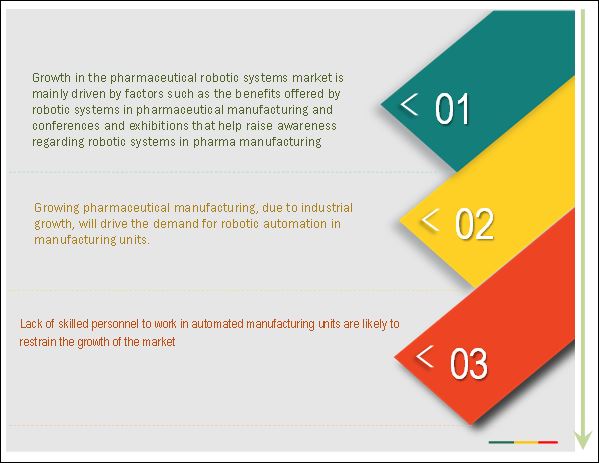Pharmaceutical Robots Market : Government Initiatives to Increase Robotic AutomaPosted by Dheeraj Shaha on December 11th, 2020 Robotic systems provide various benefits to pharmaceutical manufacturing such as lesser space utilization, reduced production downtime, no labor turnover, enhanced health and safety, better waste management, increased production flexibility, improved production output and product quality, and lower operating costs. Pharmaceutical robotic systems market is expected to grow from USD 64.37 million in 2016 to USD 119.46 million by 2021, at a CAGR of 13.2% from 2016 to 2021. Pharmaceutical Robots Market by Type (Traditional Robots (Articulated Robots, SCARA Robots, Delta Robots, Cartesian Robots), Collaborative Robots), Application (Picking and Packaging, Laboratory Applications) .
A robotic system is a type of automation that has multiple axes of motion and can be programmed to perform a function. Some of the benefits of automation include efficiency, saving workers from hazardous environments or repetitive tasks, reducing training overhead, eliminating human error, increasing repeatability and reproducibility, and in cleanrooms, removing the potential for human contamination. On the basis of application, the global pharmaceutical robotic systems market is segmented into picking and packaging, inspection of pharmaceutical drugs, and laboratory applications. The picking and packaging segment accounted for the largest share of the global pharmaceutical robotic systems market. Factors such as demand for personalized packaging configurations and advantages of robots in pharmaceutical manufacturing such as high speed, accuracy, ability to track and trace, error-free operation, fewer accidents, and better utilization of the floor space are contributing to the large share of the picking and packaging segment. Automation is becoming an increasingly important part of pharmaceutical manufacturing. A robotic system is a type of automation. Robots offer various advantages, such as high efficiency, save workers from hazardous environments and repetitive tasks, reduce training overheads, eliminate human errors, and increase repeatability and reproducibility. The common applications of robots include pick and place operations that often use SCARA robots. Region Covered in Pharmaceutical Robots Market : The pharmaceutical robotic systems market in APAC is expected to grow at the highest CAGR during the forecast period owing to factors such as the increase in domestic industrial robots companies, flourishing pharmaceutical industry, increasing number of conferences and exhibitions, investments and funding in the industrial robots industry, and Japan’s Robot Strategy. Robots are increasingly being used in laboratories to improve quality and efficiency. Many tests associated with research, discovery, and development involve repetitive tasks such as moving fluids between wells in a plate. Pharmaceutical laboratories are now using robots to perform these tests as they are easy to automate. Moreover, robots offer a high degree of consistency and accuracy executing test protocols, while at the same time allowing researchers to focus on higher-value tasks. Leading Companies : Kawasaki Heavy Industries Ltd. (Japan), FANUC Corporation (Japan), KUKA AG (Germany), Mitsubishi Electric Corporation (Japan), ABB Ltd. (Switzerland), Denso Corporation (Japan), Seiko Epson Corporation (Japan), Marchesini Group S.p.A (Italy), Universal Robots A/S (Denmark), Yaskawa Electric Corporation (Japan), and Shibuya Corporation (Japan). Like it? Share it!More by this author |



